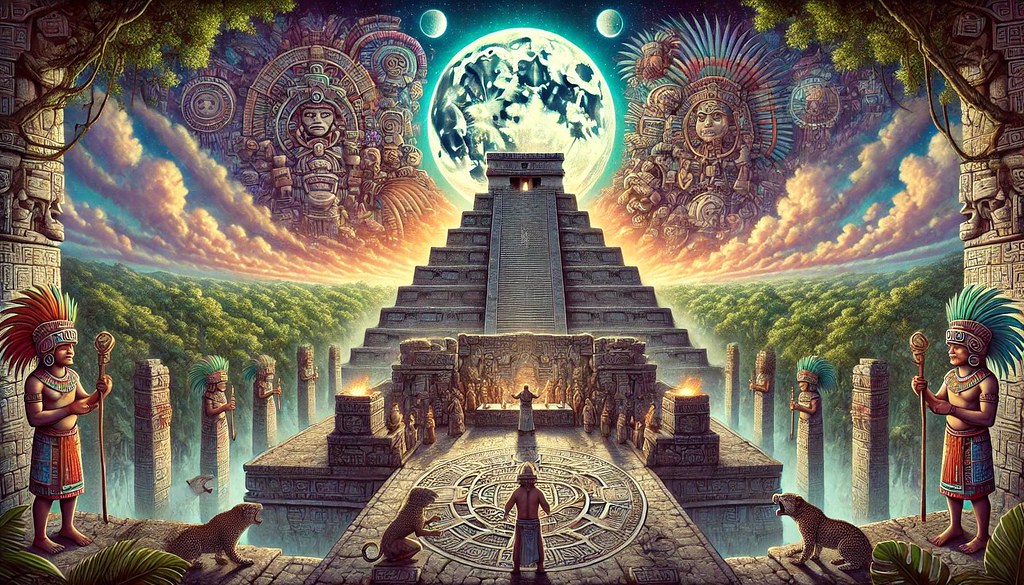

Ab Kin Xoc In Mayan mythology, god of poetry, also known as Ppiz Hiu Tec SEE ALSO: Mayan Mythology Meso ...

When the Conquistadores arrived in Central America in the sixteenth century, they were appalled to discover that not only did ...

Ah Puch (Ahpuch, Ahal Puh, Ah-Puchah) (to melt, to dissolve, to spoil) In Mayan mythology, god of death, the destroyer, ...

Ah Raxá Lac (the lord of the green plate) In Mayan mythology, an earth god, mentioned in the Popol Vuh, ...

Ah Raxa Tzel (the lord of the green gourd or blue bowl) In Mayan mythology, a sky god or personification ...

Ahtoltecat is in Mayan mythology, the silversmith god of the Quiché Maya of Guatemala, patron of the Toltecs, skilled silversmiths ...

Ahulane is in Mayan mythology, archer god, portrayed holding an arrow. Ahulane was worshipped on the island of Cozumel, where ...

Ajitz is a Mayan word meaning “shaman,” “healer,” “wizard,” or “holy man” and is also the name given the spirit ...

Bacabs (erected, set up) In Mayan mythology, four giant brothers who supported the four corners of the heavens, blowing the ...

Camazotz: Snatch Bat; Death Bat Long before Dracula, there was Camazotz, spirit of death in the form of a bat ...

Chac (Chaac) In Mayan mythology, four-part god of rain and thunder, patron of the number 13. Chac is the Mayan ...

Chay In the mythology of the Cakchiquel Maya, obsidian stone from which they made their cutting tools and ornaments; worshipped ...

Gagavitz (hill of fire) In the mythology of the Cakchiquels, a branch of the Mayan Indians, progenitor and culture hero ...

Hunahpú and Xbalanqúe are in Mayan mythology, the twin hero gods in the Popol Vuh, the sacred book of the ...

Hurakán (Huracán) (the one-legged) In Mayan mythology, a creator god. In the beginning, according to the Popol Vuh, sacred book ...

Itzamna - He of the Writing Itzamna is the preeminent deity of the Mayan Yucatan peninsula. Itzamna is the Lord ...

Ix Chel - Lady Rainbow; Old Woman with the Jaguar Claws; Lady Splotch of Blood; Lady All Embracer Ix Chel ...

Ix Tab : Lady of the Rope According to ancient Mayan cosmology, among those who go straight to Paradise after ...

Kukulcan is the Mayan plumed or feathered serpent. Is he the same spirit as Quetzalcoatl? That’s subject to debate. • ...

Maximon : The Old Man; The Uncle Christian missionaries who came to Guatemala to convert the local people encountered the ...

The calendar system of the classic Maya, the most elaborate calendar system of medieval Central America, has recently become a ...

Xtabay, Mayan jungle goddess, is the subject of many legends told throughout the Mayan and Mayan-influenced world, most of them ...

Zakiqoxol (Zaquicoxol) (he who strikes from flint) In the mythology of the Cakchiquels, a branch of the Mayan Indians, Demon ...

Zipacna (Mountain Mover) Son of the giant stone man Vukub-Cakix from the Quiché myths recorded in the PoPol Vuh. The ...

Zotz is a fearsome Mayan Demon and a lord of the underworld. Zotz is a huge winged being with the ...
The Mayan people were exceedingly religious. They erected a great number of pyramid and square temples which were brightly painted with pictures of gods, warriors, and high officials. All Mayan celebration and in fact almost every aspect of life was connected with religion. Mayan festivals were based on agriculture and the abundance of it, and the seasons.
Little is actually known of their celebrations, but what is known is that there were 18 months in the Mayan calendar and each of these months had it’s ceremonies. Fasting was a common preparation for these ceremonies which usually included large feasts, heavy drinking and sometimes orgies.
According to what we know of Mayan myth, in the beginning after the gods were formed (which is unknown how they were formed), there was only sky and water.
Two of the gods typically named Quetzalcoatl and Tohil, took Hungry Woman and tossed her down upon the ocean. Then they each took hold of an arm and leg, stretching her until the Earth was formed. Since these gods had treated Hungry Woman so roughly, they gave her the right to a type of human sacrifice, the right to eat the dead when they were buried within her.
Then the Dieites decided that they needed creatures who could talk to them by prayer and ritual so they created three races of beings before they finally managed to form humankind. The first race was the ancestors of the animals of today which were unsatisfactory to the Gods because they could only talk through noise. The second race was made of mud and also proved unsatisfactory. The third time the deities formed creatures out of wood, but this too was troublesome.
Although these wood creatures could multiply they had blank minds and no knowledge or care for their creators. Lastly, humanity was created to the delight of the gods. Here was the race of creatures that could learn and were willing and able to communicate with the deities.




































